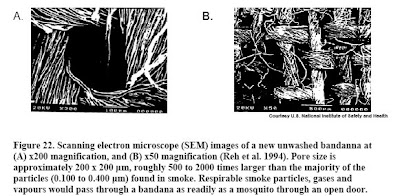Here is an excerpt from the report's abstract:
The substances of greatest concern are carbon monoxide, formaldehyde, acrolein, and respirable and inhalable particles. A second group of concern, but present at proportionally lower concentrations, includes benzene, carbon dioxide (CO2), nitrogen oxides, PAH, ammonia, and furfural. A third group of concern, but present at proportionally lower concentrations again, includes acetaldehyde, 1,3-butadiene, methane, methanol, styrene, acetonitrile, propionaldehyde, toluene, methyl bromide, methylethylketone, acetone, methyl chloride, xylenes, phenol, tetrahydrofuran, methyl iodide, and mercury. Data suggests that if wildland firefighters are exposed to 25 ppm of carbon monoxide (below the permissible exposure value), they may be overexposed to formaldehyde, acrolein, PAH (benzo[a]pyrene), and respirable particles.
The U.S. National Fire Protection Association has recently announced that it is proceeding with the development of a new wildland firefighting respiratory protection Standard, but it will be some time still before respirators certified for wildland firefighting will become available.
If administrative controls are unsuccessful in reducing exposures to acceptable levels, wildland firefighters should be provided with air purifying respirators for formaldehyde, respirable particulate matter, organic vapours and acids, acrolein, and PAH. However, wildland firefighters should be cautioned that at high work levels the effectiveness and duration of air purifying cartridges is unknown. There is also a concern that firefighters using air purifying respirators may unknowingly expose themselves to higher levels of contaminants not removed by their respirator than they would otherwise. Until a respirator is developed for wildland firefighting that effectively removes carbon monoxide, air purifying respirators should be used in conjunction with a carbon monoxide alarm.
Like "a mosquito through an open door".
Firefighters, especially new ones, frequently ask if bandannas over the face will protect them from smoke. The answer is hell no.
"Respirable smoke particles, gases, and vapours would pass through a bandanna as readily as a mosquito thorugh an open door."
In fact, even respirators, as inconvenient as they are, will not do the job according to the report.
None of the filtering respirators remove carbon monoxide (CO). All of the currently available respirators have serious shortcomings for use in a wildland fire situation. Even if they were effective, some wildland firefighters are understandably reluctant to accept negative pressure air purifying face masks for use at high work levels for long periods of time.So, forget about the bandanna, and throw away that $84 piece of crap Hot Shield mask that is advertised to have the " benefit of blocking & reducing the inhalation of smoke & ash particulate". These smoke particulates are so small, that if one were released near the ceiling in a room with calm air, it would take eight hours to fall to the floor.
A full face mask is generally more comfortable than a half-face mask and it provides full eye protection. Full eye protection is necessary the case of contaminants exceeding the threshold limit value where the threshold limit value is based on irritant effects.
Since the contaminants having warning properties such as odour or irritant effects are removed by air purifying respirators, there is a legitimate concern that firefighters wearing such respirators might unknowingly expose themselves to higher levels of toxic contaminants not removed by the respirator than they would otherwise. This could easily result in over exposure to carbon monoxide and lead to serious, perhaps deadly, consequences. To avoid this, a carbon monoxide monitor with alarm should be used in conjunction with air purifying respirators used when fighting wildland fires.
The sad truth is, in 2008 there is no practical way to protect wildland firefighters from the byproducts of combustion. Maybe the new 8-pound SCBA being developed will lead to something that could benefit wildland firefighters. Using this new technology, perhaps a 15-pound unit would give you an hour's worth of air? This might help for initial attack, but for the hot shot crew on the line for 16 hours, sorry, you're out of luck.





2 comments:
What about the white dust masks burned out homeowners have been wearing around Freeway Fire cleanup? Are they useless too post-fire?
My guess is that those dust masks will not filter out any of the toxic gases, but may remove some of the larger dust particles that are kicked up when you are in a burned area.
Post a Comment